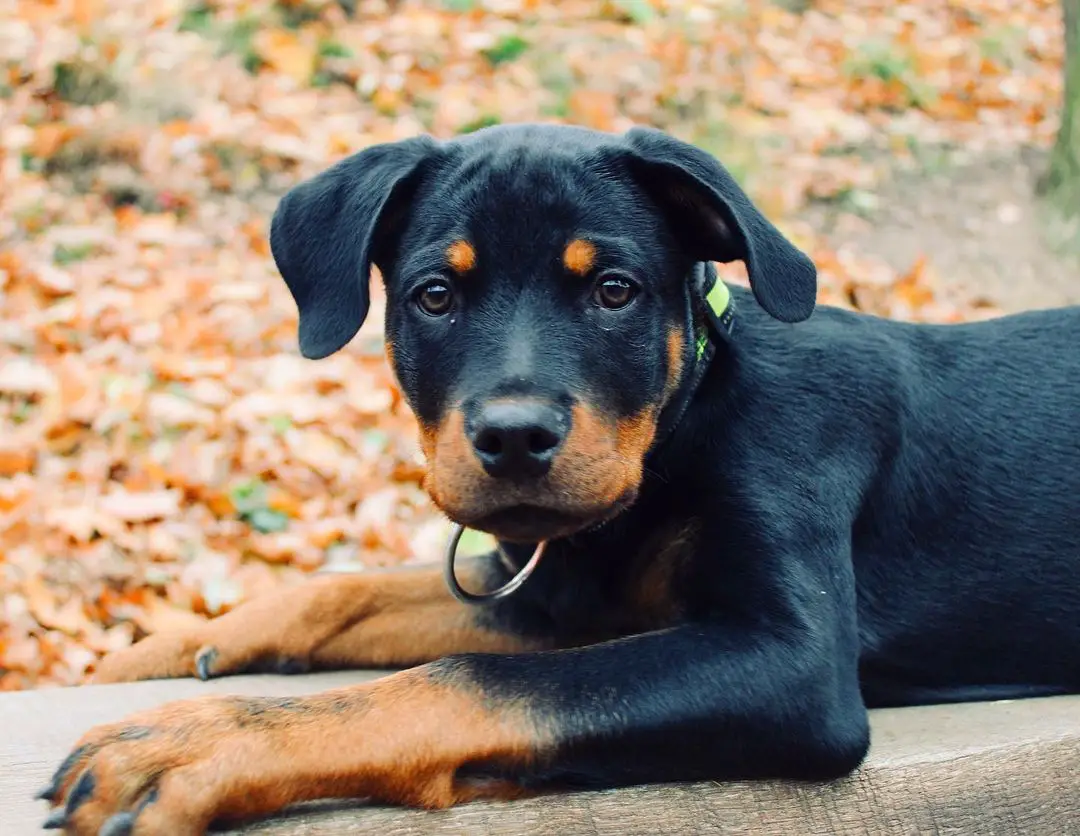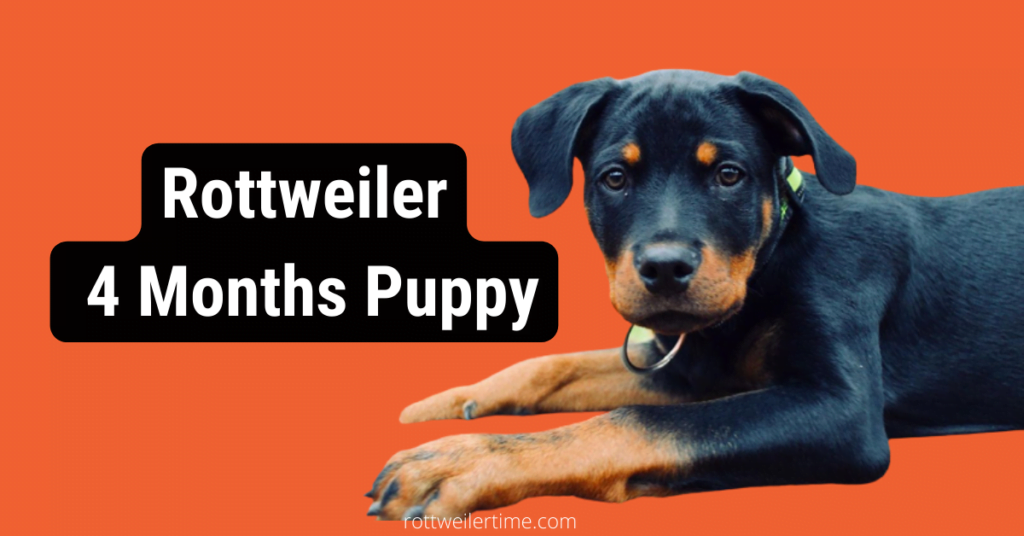Rottweiler Puppy 4 Months are going through a lot of changes at this stage in their life, so you will want to keep an eye on them and be prepared to help them through any difficult times that may come along.
Read on to learn more about the month-by-month changes you can expect from your puppy during their fourth month of life so that you can be prepared when they come around!
Contents
- 1 What Do a 4 Months Old Rottweiler Look Like
- 2 Rottweiler 4 Months Puppy General Care Guide
- 3 What To Feed a 4 Months Old Rottweiler puppy
- 4 How Much Should a 4 Month Old Rottweiler Eat
- 5 Rottweiler Puppy 4 Months Weight
- 6 Diet Guide For 4 Months Old Rottweiler Puppy
- 7 General Health Guide
- 8 Vaccination
- 9 Exercise Guide For A 4 Months Old Rottweiler
- 10 Final Thoughts
What Do a 4 Months Old Rottweiler Look Like
At four months old, you’ll find that your puppy is growing like a weed and looks more like an adult dog. He has begun to grow out his fur, except for his paws, which are still bare.
At four months, he should weigh anywhere from 44 – 51 lbs and stand at least 17 inches tall at shoulder height. He’s starting to develop a wide-jawed rottweiler snout too!
Despite being almost adult size now, your Rottie still needs plenty of exercise and socialization. If you see any teeth coming in at around four months, be sure to start keeping him leashed whenever he’s outside; it will be hard enough teaching him not to bite humans without having loose dogs running around as well!
Here are a few images of a 4-month-old Rottweiler Puppy




Rottweiler 4 Months Puppy General Care Guide
It’s never too early to start a grooming routine. Your pup may hate it now, but if you establish healthy habits early on, you can avoid issues later in life. Choose your tools wisely and invest in high-quality products that won’t cause irritation.
Products for cleaning ears should be non-irritating and pH balanced for a puppy’s sensitive ears. Quality brushes are best for getting loose hair from their coats; coarse brushes work better than fine ones since they don’t damage fur as much.
Rottweilers have thick double coats with a short layer of undercoat. Their fur is water-resistant but thin enough to breathe comfortably underneath—keeping them warm when they need it and cool when they don’t.
Start grooming early by brushing your pup once a week.
Shorten her fur with clippers when she’s between four and six months old, but keep it just long enough so you can comfortably run your hand underneath. Brush her two to three times a week to avoid tangles and reduce shedding later in life.
During warmer months, keep an eye out for ticks and fleas; apply tick-control medication as needed and use natural or chemical-free flea sprays on her bedding to prevent infestations in your home.
At least once a month during warmer weather, bathe him using a quality shampoo designed for Rottweilers that doesn’t contain any artificial scents or dyes that could irritate his skin.
Read Detailed Article: Rottweiler Puppy General Care Guide
What To Feed a 4 Months Old Rottweiler puppy
A Rottweiler puppy at four months old will be taking adult dog food. But it should not be a full-sized meal. A standard portion for a sixteen-week-old puppy is 1⁄4 to 1⁄2 cup of dry food twice a day, split between meals and three times daily by four months old.
Consult your vet if you have questions about how much to feed your pup. If you’re using canned dog food instead of dry, use half as much (again, a typical amount for a 16-week-old pup is 1⁄4 cup twice daily). Keep in mind that some cans are more than others—this goes for both wet and dry varieties—so don’t rely on weight to measure out amounts accurately; go by volume instead.
Also remember that puppies under four months shouldn’t eat table scraps or human food, no matter how hungry they get. It can upset their stomachs and make them sick.
How Much Should a 4 Month Old Rottweiler Eat
The amount of food a puppy needs will depend on how much she/he weighs. The basic equation is to divide your dog’s weight in pounds by two and feed her that number of calories per day.
If you don’t know her weight, try using a scale (you can buy one for $30 to $50) and weighing her every week or so. Keep in mind that puppies tend to have short bursts of energy followed by naps, so it doesn’t make sense to schedule three meals per day for them as it does for adult dogs (or people).
Rather, divide her total caloric requirement into three meals spaced out evenly throughout the day.
Read Also: How Often Should Rottweiler Puppies Eat | The Brief Guide
Rottweiler Puppy 4 Months Weight
A Rottweiler puppy at four months is a sturdy and active animal. He should now weigh in at around 25 kg (55 pounds).
(wight may vary depending on dog lines, demographics & other factors, please ask your breeder about a parent’s past weight history)
Although he is growing quickly, his bones are still quite soft, which means that over-exertion can result in something called growth fatigue. When that happens, it can cause permanent bone damage.
It’s important to keep your Rottie pup active but not too active; take him on regular walks but don’t subject him to more than a mile or two per day and don’t let him jump from high places or run on hard surfaces.
Over-exerting your dog may also cause muscle injury as his muscles is still developing.
Read Full Article: Rottweiler Weight & Growth Chart – Complete Guide
Diet Guide For 4 Months Old Rottweiler Puppy
Because of their size, Rottweilers need more nutrition than other breeds. Be sure your puppy is getting plenty of exercises and has regular access to food, water, and clean-up areas.
Rottweilers should always be fed a high-quality dog food appropriate for their age that meets or exceeds current AAFCO recommendations. As your puppy grows, you can use a standard measuring cup to calculate how much food it needs per day—feed accordingly and adjust as needed based on how active your puppy is.
Remember that puppies grow quickly and require large amounts of energy; they will likely eat more often than an adult dog would—but make sure not to overfeed!
Read Also: Common Mistakes People Make About Rottweiler Diet
General Health Guide
To be a great dog, your Rottweiler puppy needs to stay healthy. Although four months is young for neutering or spaying, ask your vet about these procedures now—it’s never too early. Also, you can now start vaccinating your pup against common diseases such as distemper and parvo.
Remember: The earlier you start vaccination, the better it works, so begin as soon as possible! Other health matters to consider include shots for kennel cough and tick-borne illnesses (ask your vet if you live in an area where ticks are a problem).
Now that your pet has reached four months of age, also look into flea control products for dogs.
Vaccination
The vaccinations your Rottie will need vary depending on his age, where you live, and other factors. Most veterinarians recommend getting these shots about a month after bringing your pup home for the first time.
These vaccinations protect against distemper, hepatitis, parainfluenza, and parvovirus—all of which can be deadly to your dog and spread easily between animals.
Once your puppy has had his initial round of immunizations (generally around 6 to 8 weeks old), he’ll need boosters every 3 to 4 weeks until he is 16 weeks old; then they become less frequent and continue until he reaches adulthood at 1 year old.
Exercise Guide For A 4 Months Old Rottweiler
At four months, your puppy will be much more active than he was at three months. He’ll now be able to exercise for extended periods of time without getting too tired, which is great news.
Your best bet for keeping him healthy and happy? Just like a newborn baby, he’ll need daily exercise and interaction with his family. Staying home all day is no longer an option for your pup – if you want him to remain healthy and happy, you must take him outside on a leash multiple times per day to give him some exercise.
You should also begin teaching him basic commands such as sit or stay in order to provide enrichment for his life while staying on top of his training. As always, don’t forget to reward good behavior!
Final Thoughts
The first months with your Rottweiler puppy are incredibly important. In fact, everything you do with him during these early stages is something that he’ll remember for years to come. Your puppy will never forget where he slept his first night in your home, who he met on his first day out of his mother’s care, and what experiences and learning occurred during that crucial four-month period. With that said, here are a few final tips to keep in mind

